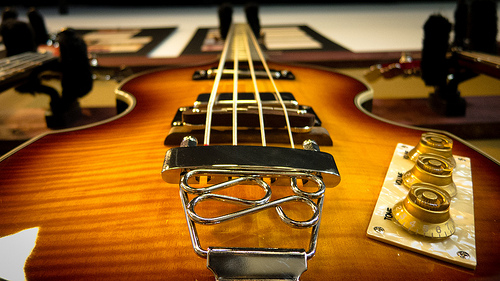The Gibson Guitar Corporation was originally founded in 1902, with the aim to produce high quality mandolin family instruments. Gibson built a global reputation over the next 30-years, becoming associated with quality musical instruments including acoustic guitars.

Growing Gibson
Gibson’s true prowess didn’t become known, however, until the mid-1930s, when they pioneered their first electronic pickup with musician Alvino Rey and engineers from Chicago-based Lyon & Healy. Gibson’s own Walter Fuller would produce the final designs for their first pickup, and Gibson’s first commercially produced guitar, the ES-150 (ES for Electric Spanish, 150 for the $150 cost), shipped in May 1936.
The ES-150s Popularity
At the time of launch, musicians around the world were calling the ES-150 the best guitar ever produced. However, it was a model not without its problems, the biggest of which was the uneven sound that was produced across all six strings. This was the first guitar to come with an amplifier as standard, too, and helped to establish Gibson as the leaders in the market that they remain to this day.
Even now, after almost 80 years of additional innovation and research, people still consider the original ES-150 pickup to be the finest ever produced.
Post War Innovation
While the Second World War hit Gibson, not to mention businesses across the world, hard, they would quickly pick up where they had left off almost a decade earlier.
The first big post war innovation from Gibson was the P-90 pickup, launched in 1946, which was designed to give a more powerful sound and allow musicians to be more flexible with how they played. These were quickly followed by the ES-5 guitar (no, it didn’t cost $5), which was the first to have three pickups, the standard today, and the ES-175.
Gibson’s Golden Years
The only problem Gibson faced during these years was that they were continually setting the bar higher for themselves in terms of what they could achieve with an instrument.
In 1952, they would release the Gibson Les Paul, designed and developed with Les Paul himself, a legendary musician who many consider to be the godfather of modern guitar. This would spawn a number of designs and become a whole range, and was the first guitar to feature the tune-o-matic bridge, pioneered by then Gibson President Ted McCarty, which is still the standard on all Gibson guitars today. An endorsement from the world’s leading guitarist at the time did wonders for Gibson’s fortunes, and built on the popularity and success of the early Gibson electrics to further strengthen their brand and market position.
McCarty’s Innovations and Departure
McCarty would leave Gibson in 1966 following a takeover that for some time saw the future of the company subject to much doubt, but before then he would give Gibson the products and legacy that we see today.
Throughout the late 1950s and early part of the 1960s, McCarty would lead Gibson as they produced legendary models like the Flying V and the Firebird, which remain among the world’s most popular instruments to this day.
Image Source: Nan Palmero
Are you a guitarist? Check out our full range of online guitar lessonsAre you a saxophonist? Check out our full range of online saxophone lessons
Subscribe to Pro Music Tutor from as little as £7.99 per month
Related Posts
-
Is Music Theory Important to Modern Musicians?
The importance of music theory is a hot debate topic in the world of professional music. Some believe knowledge of music theory is what makes you a true musician, whereas some feel their lack of music theory knowledge is like a badge of honour. With the eternal debate over the importance of music theory raging […]
View All >> -
5 Ways Spanish Music Influenced the World
Contemporary popular music has transcended all national boundaries, with different types of music being performed and listened to in all corners of the world. Each culture also adds their own little tweaks and twists to the music, constantly creating new sounds and influences. Spanish music has deeply influenced the popular music we listen to today. […]
View All >>
Latest Blog Entries
-
The Benefits of Online Music Education
Learning music has never been easier, since the internet and modern technological advancements have opened the doors to countless possibilities, expanding the subjects people can choose from and how the lessons are taught. Now, people can study a whole host of music-related topics; from learning to play guitar or DJing, to understanding the inner workings […]
View All >> -
Essential Jazz Guitar Scales that are Easy to Learn
Improvising in jazz requires the ability to play in different keys over different chords. Results certainly do not come overnight, but with diligent practice, you would be surprised by what you can achieve. Many people ask me about what scales I use as if they were some big secret. While knowing your scales is very […]
View All >>
Blog Categories
- Categories
- Guitar Tips (93)
- History (36)
- How-To (38)
- Interviews (3)
- Music Industry (121)
- Prolinks Guitar (2)
- Prolinks Lessons (3)
- Prolinks Tutor's Profile (1)
- Saxophone Tips (40)
- Uncategorized (6)
Tags
Archive
- November 2018 (1)
- February 2018 (1)
- December 2017 (1)
- November 2017 (1)
- October 2017 (1)
- July 2017 (4)
- May 2017 (2)
- April 2017 (1)
- August 2016 (2)
- July 2016 (1)
- June 2016 (2)
- May 2016 (3)

